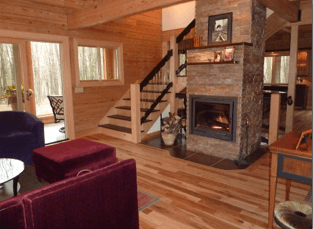
Mimicking the Earth's atmosphere and its ability to capture and store heat, Enertia homes have an outer and inner shell to boost energy efficiency and comfort. The inner shell, containing the living room, bedrooms, bathrooms, dining room and kitchen, remains at a relatively constant temperature despite fluctuations in outdoor temperatures and conditions. Mimicking the trade winds, the outer shell circulates air between the basement and the attic, which are connected through a sunroom in the outer shell.
In the summer, when the angle of the sun is higher in the sky, the sun heats up the air in the attic. The vent releases the hot air, which causes cold air to enter through the north basement windows.
These homes are designed by Michael Sykes, an engineer and founder of Enertia Building Systems, a company based in Youngsville, North Carolina. "People inside are getting their warmth, not from hot air, which would be stifling, but you’re getting your warmth from warm floors and walls, so you can actually tolerate a cooler house and still be comfortable," he says.
Occupants can open the doors between the sunroom (outer shell) to the inner shell, boosting indoor temperatures and reducing the need for auxiliary heat. Ceiling fans in the sunroom help kickstart the airflow in the outer shell. Sykes says that homes in the sunny West do not require HVAC systems. Because of the passive solar orientation, the sun can reliably heat the home in the winter, and the cooler basement temperatures cool the home in the summer. Due to cloudy winter weather, he does recommend radiant floor heat in Enertia homes, in most of the Northeast and Midwest.
He estimates the cost is 10 to 15 percent greater for a home with a double shell, but this upfront cost is offset by a significant reduction in energy costs. The design varies slightly depending on the climate. For example, structurally integrated panels (SIPs) used in the roof are thinner in Florida than in Connecticut, where less insulation is needed. The "Extreme" Enertia house design was created for cold climates and can withstand temperatures up to -60 degrees Fahrenheit.
Since the boards are precut, the design has to be determined before construction begins and doesn't allow spontaneous design changes. Because Enertia precuts and numbers the tongue and groove boards, they are easy to assemble using an electric drill. There is very little waste on the job site because there are no scrap boards, reducing waste collection costs and environmental impact. Some homeowners choose to build the homes themselves, reducing the upfront cost of the home.
The cost of the homes varies by the design and size. The simplest double-envelope design is the 1,000-square-foot (plus a basement) Acadia with two bedrooms, starting at $66,400. This price includes a shell and doesn't include additional features, such as porches or solar panels, site work, or construction costs. Sykes says that southern yellow pine is cheaper in North Carolina than in Oregon and elsewhere, helping to keep the cost of the home down, or depending on the location, offsetting the shipping costs. The resin in the southern yellow pine stores heat, captures energy from the sun to boost comfort and reduce the use of fossil fuels, according to Sykes.
Although Enertia customers pay a premium for this solid wood, double envelope construction, customers rave about comfort, low utility bills, and generous day lighting. For people looking for a custom, energy efficient home, Enertia Homes are a really good option.
Photo Credit: Enertia Homes
https://www.youtube.com/watch?v=1gY8XZ6EWik

Sarah Lozanova is an environmental journalist and copywriter and has worked as a consultant to help large corporations become more sustainable. She is the author of Humane Home: Easy Steps for Sustainable & Green Living, and her renewable energy experience includes residential and commercial solar energy installations. She teaches green business classes to graduate students at Unity College and holds an MBA in sustainable management from the Presidio Graduate School.














